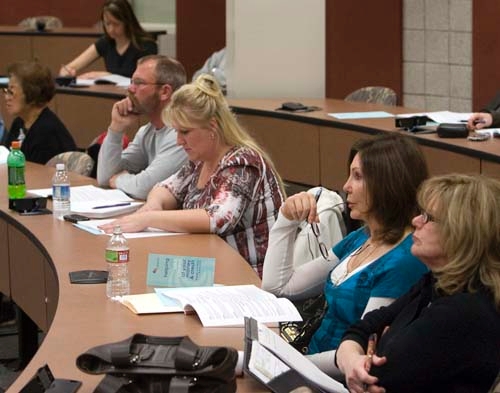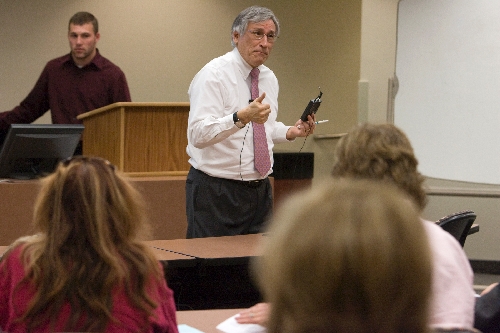Federal aid program fails to help many
PART TWO
Editor's note: From the North Las Vegas subdivision profiled in Sunday's Review-Journal to nearly every corner of the Las Vegas Valley, the housing collapse has put enormous weight on communities.
In today's second of a two-part package, housing experts, policymakers and bank officials discuss the challenges of implementing programs that can make a difference for average homeowners.
In Southern Nevada, an area known as ground zero of the nation's housing crisis, far fewer people than expected have received home loan modifications through a $75 billion stimulus program designed to reduce the impact of foreclosures on communities.
More than a year into the initiative, only about 4,000 local homeowners have qualified for permanent adjustments under the Home Affordable Modification Program, or HAMP. To put that number in perspective, about 7,400 homeowners in Clark County received notices of default in February alone, according to ForeclosureRadar.com, which tracks housing data in several Western states.
Another major stimulus initiative, the Neighborhood Stabilization Program, has also yielded disappointing results in Southern Nevada. In January, the region was denied hundreds of millions of dollars in program funding to help put families in foreclosed and empty homes.
Earlier this year, on the first anniversary of the signing of the American Reinvestment and Recovery Act, Senate Majority Leader Harry Reid, D-Nev., praised the legislation's positive impacts in sectors including energy, transportation, and education. Notably absent, however, was any mention by Reid of how stimulus money has helped alleviate the local housing crisis.
President Barack Obama's announcement in February that Nevada and four other states would share $1.5 billion in additional federal aid aimed at the housing woes was tacit acknowledgement that stimulus programs to date have not brought relief to enough homeowners.
So why have current programs failed to this point?
"They tried to design things in Washington that would fit every market," said Assembly Speaker Barbara Buckley, a Democrat from Las Vegas. "But what works in Milwaukee might not work in Las Vegas."
Buckley, who was the primary sponsor of a bill last year that created a foreclosure mediation program run by the Nevada Supreme Court, has helped spearhead a state effort to streamline talks between lenders and borrowers.
But the reality is grim: Seventy-five percent of Southern Nevada homeowners are underwater on their mortgages, meaning they owe more on their loans than their homes are worth. That is far and away the highest rate in the nation, according to a recent report by First American CoreLogic, a Santa Ana, Calif.-based company that compiles national mortgage data.
And help from Uncle Sam can only go so far.
While the government has made available $75 billion to the entire nation to help millions of homeowners with loan modifications, Nevada homeowners have close to $25 billion in negative equity.
Last year, when the federal government rolled out its foreclosure prevention program, Rep. Dina Titus, D-Nev., said she was optimistic it would bring widespread relief to this area.
These days, however, she travels around her 3rd Congressional District, reflecting on the failure of federal efforts to help with the local housing debacle. She has expressed her frustration in several pointed letters to Obama.
"The thought was that the banks would be more willing to negotiate with people than take their houses back in foreclosure," she told the Review-Journal. "I think we have to get the banks more involved in this."
Titus was talking in large part about HAMP, the Treasury Department's foreclosure-prevention initiative that runs through 2012.
Under HAMP, borrowers who have a financial hardship, are delinquent on a loan or are at risk of default on a loan that originated on or before Jan. 1, 2009, can receive a loan modification if their current mortgage payment is greater than 31 percent of their gross income. Another eligibility requirement is that the amount owed on the mortgage can't exceed $729,750.
Those who qualify for the program can have interest rates cut to 2 percent for five years, with the period of a loan extended up to 40 years. If a borrower qualifies for a modification and makes three successive payments on time, the trial modification has a chance to become permanent.
The program sounds OK on paper, but it isn't working because too much decision-making authority is ceded to lenders, said Morris Davis, a University of Wisconsin economist.
"The bottom line is that a loan modification is only offered when it's in the financial interest of the lender to do so," he said at a recent Nevada Housing Division hearing. "One way to think of HAMP is to realize we're having (loan) servicers administer public policy."
To determine whether to offer loan modifications, banks and other lenders use what is called a "net present value test," a complex set of calculations that quantify the benefits and risks of any given modification. But a recent study by the Federal Reserve Bank of Boston concluded that lenders have more financial incentive to foreclose on homes than to offer loan adjustments.
Several Las Vegas families interviewed by the Review-Journal said they have been unable to get modifications, even after they've been screened for eligibility by housing counselors and submitted required paperwork to banks.
About a year ago, Marvin Mosley and his wife, Andrea, sought a modification from Bank of America on their 30-year fixed-rate mortgage after both had their hours and pay cut at work. They wanted to make sure they didn't lose the modest 1,400-square-foot home in North Las Vegas that they bought in 2006.
The Mosleys are still waiting for an answer but remain hopeful that the bank will step up and do something before their monthly mortgage payment of $1,700 becomes unmanageable.
"We waited until we could afford a home to buy one, but we're making less money than we did when we bought the house," Marvin Mosley said. "We're just looking for a payment that's in the ballpark of sanity."
Other families told the newspaper that sudden unemployment has rendered them incapable of continuing to pay off mortgages.
Jumana Bauwens, a Bank of America spokeswoman, said she understands homeowners' frustrations but added that her company has added 15,000 people to work with customers on default management. In addition, the bank announced last month it would increase the number of principal reductions to borrowers.
Bank of America, which Reid called out last year for not doing enough to help Nevada homeowners, services about 20 percent of mortgage loans nationwide. But more than a dozen other servicers have a higher rate of trial and permanent loan modifications than Bank of America, according to Treasury Department data.
Bauwens said a homeowner's high debt-to-income ratio brought on by unemployment is a key obstacle to getting a modification. The government recently announced a plan to provide additional help to these borrowers.
"We have to go by each person's individual scenario to see where they stand," Bauwens said. "Sometimes it's very simple and straightforward, other times it's not."
Buckley, who is also executive director of the Legal Aid Center of Southern Nevada, said banks need to do more:
"We have lenders who aren't complying with (HAMP) and there's no accountability. People are getting trial loan modifications, but not enough of them are becoming permanent."
Treasury Department spokesman Meg Reilly said the government is working to make banks more accountable.
"We recently began collecting more detailed information about borrowers and their loan characteristics from servicers and expect to report more of these details in the coming months," she told the Review-Journal earlier this year.
Some housing experts argue that even those borrowers who get modifications aren't benefiting in the long term because few are getting principal reductions.
"You might have an affordable rate, but you still have homeowners with a mountain of debt trapped in their homes," said Sean O'Toole of ForeclosureRadar.com. "Yes, we have a foreclosure crisis, but we also have an unsustainable debt crisis."
Contact reporter Alan Maimon at amaimon@reviewjournal.com or 702-383-0404.
The Foreclosure Game
RELATED STORY
Real estate auctions remain active, draw eclectic clientele
PART ONE
Fortunes rise and fall for one North Las Vegas neighborhood
























